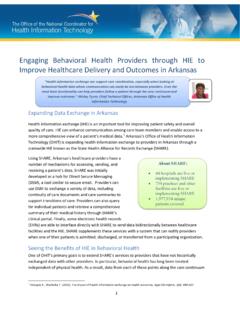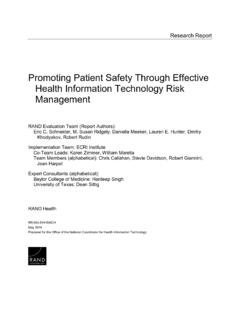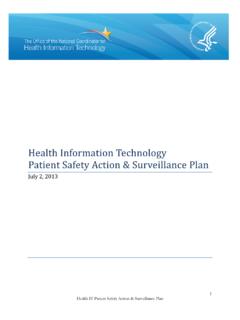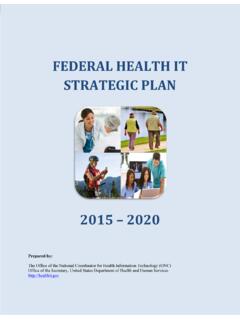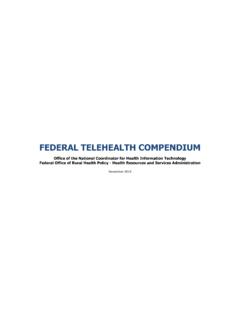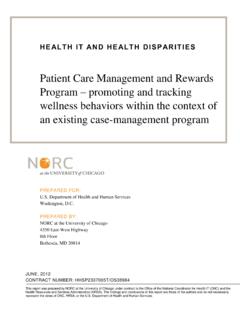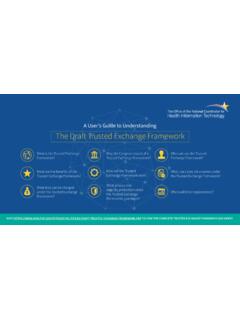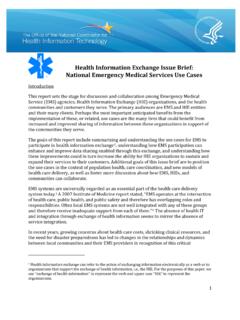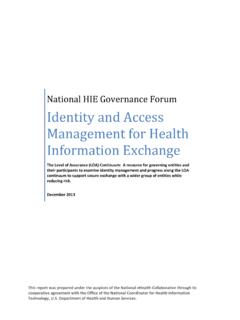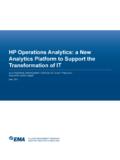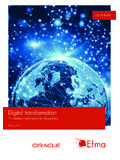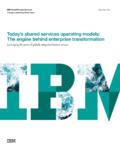Transcription of 2018 Report to Congress - Annual Update on the Adoption of ...
1 2018 Report to Congress Annual Update on the Adoption of a Nationwide System for the Electronic Use and Exchange of Health InformationAnnual Update on the Adoption of a Nationwide System for the Electronic Use and Exchange of Health Information 2 CONTENTS CONTENTS .. 2 Statutory Requirement .. 3 Executive Summary .. 4 Current State ..4 Future State ..5 Current Barriers ..6 Current and Upcoming Actions ..6 Recommendations ..7 Introduction .. 8 Health IT Progress Update .. 9 Barriers to Progress .. 12 Barriers associated with health IT capabilities and data sharing .. 12 Barriers associated with health care providers experience with health IT.
2 13 Actions Taken .. 14 Action taken associated with health IT capabilities and data sharing .. 14 Actions taken associated with end user experience with health IT .. 19 Recommendations .. 20 References .. 21 Annual Update on the Adoption of a Nationwide System for the Electronic Use and Exchange of Health Information 3 Statutory Requirement Section 13113(a) of the American Recovery and Reinvestment Act of 2009 under Title XIII of Division A, part of the Health Information Technology for Economic and Clinical Health (HITECH) Act, is the underlying statutory requirement for ONC s Annual Report to Congress : (a) Report ON Adoption OF NATIONWIDE SYSTEM.
3 Not later than 2 years after the date of the enactment of this Act and annually thereafter, the Secretary of Health and Human Services shall submit to the appropriate committees of jurisdiction of the House of Representatives and the Senate a Report that the specific actions that have been taken by the Federal Government and private entities to facilitate the Adoption of a nationwide system for the electronic use and exchange of healthinformation; barriers to the Adoption of such a nationwide system; recommendations to achieve full implementation of such a nationwide Update on the Adoption of a Nationwide System for the Electronic Use and Exchange of Health Information 4 Executive Summary The Department of Health & Human Services (HHS) is committed to maximizing the promise of health information technology (health IT) as a critical component in our efforts to accelerate value-based transformation in health care.
4 HHS is committed to the use of health IT to support the free flow of health information for patients, health care providers, and payers as well as to promote competition in healthcare markets. Seamless data flow will also accelerate progress on a range of national health priorities that include combatting the opioid epidemic, spurring clinical innovation, and accelerating science. For the past decade, the Office of the National Coordinator for Health Information Technology (ONC) has been the principal federal entity charged with supporting a nationwide health IT infrastructure, which allows for the electronic access and use of health information.
5 Today, most hospitals and health care providers have a digital footprint. As of 2015, 96 percent of non-federal acute care hospitals and 78 percent of office-based physicians adopted certified health However, hurdles to progr ess still remain. For example, many certified health IT products lack capabilities that allow for greater innovation in how health information can be securely accessed and easily shared with appropriate members of the care team. Such innovation is more common in other industries. Also, lack of transparent expectations for data sharing and burdensome experiences for health care providers limit the return on investment for health care providers and the value patients are able to gain from using certified health IT.
6 Current State The increase in Adoption of health IT means most Americans receiving health care services now have their health data recorded electronically. However, this information is not always accessible across systems and by all end users such as patients, health care providers, and payers in the market in productive ways. For example: Despite the individual right to access health information about themselves established by theHIPAA Privacy Rule, patients often lack access to their own health information, which hinders their ability to manage their health and shop for medical care at lower prices; Health care providers often lack access to patient data at the point of care, particularly whenmultiple health care providers maintain different pieces of data, own different systems, or usehealth IT solutions purchased from different developers.
7 And Payers often lack access to clinical data on groups of covered individuals to assess the value ofservices provided to their using modern computing tools is critical to advancing health care. P atients should be able to easily and securely access their medical data through their smartphones. Currently, patients electronically access their health information through patient portals that prevent them from easily pulling from multiple sources or health care providers. Patient access to their electronic health information also requires repeated use of logins and manual data updates.
8 For health care providers and payers, interoperable access and exchange of health records is focused on accessing one record at a time. Payers cannot effectively represent their members if they lack Annual Update on the Adoption of a Nationwide System for the Electronic Use and Exchange of Health Information 5 computational visibility into which health care providers offer the highest quality care at the lowest cost. Without the capability to access multiple records across a population of patients, health care providers and payers will not benefit from the value of using modern computing solutions such as machine learning and artificial intelligence to inform care decisions and identify trends.
9 In addition, payers and employer group health plans which purchase health care have little information on health outcomes. Often, health care providers and payers negotiate contracts based on the health care provider s reputation rather than on the quality of care that health care provider offers to patients. Health care providers should instead compete based on the entire scope of the quality and value of care they provide, not on how exclusively they can craft their networks. Outcome data will allow payers to apply machine learning and artificial intelligence to have better insight into the value of the care they Future State Health IT developers are increasingly working with hospitals and health care provider practices to identify health care provider needs and offer certified health IT that includes important upgrades that support interoperability3 and can improve user The benefits of these upgrades are reflected in ONC s most recent 2015 Edition of certification criteria and standards.
10 They will begin to show as hospitals and health care provider practices upgrade their technology to the 2015 Edition over the next few years, and as patients increasingly choose and use health IT applications that suit their needs. Congress provided HHS with authority to enhance innovation, scientific discovery, and expand the access and use of health information in the 21st Century Cures Act5 (Cures Act). The Cures Act includes provisions related to: the development and use of upgraded health IT capabilities; Annual Update on the Adoption of a Nationwide System for the Electronic Use and Exchange of Health Information 6 transparent expectations for data sharing, including through open application programminginterfaces (APIs).
